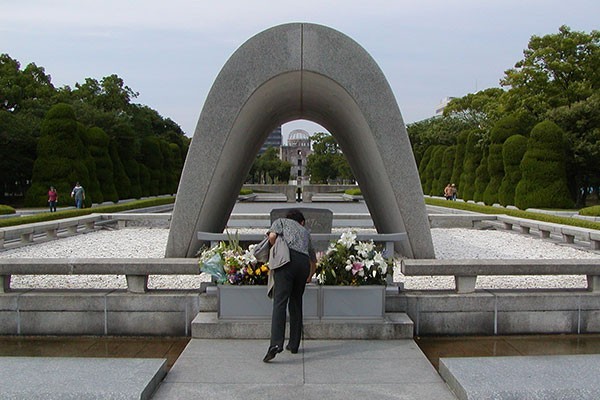A sombre group of around 30 people gathered at the Museum Reserve Peacepole on Saturday August 6, to mark 77 years since the atomic bombing of Hiroshima. Ashley Macmillan from the Department of Peace and Conflict Studies said it was a “gathering to remember the atrocity and call for it never to be repeated.”
Although estimates vary, between 129,000 to 226,000 people were thought to have been killed when the cities of Hiroshima and Nagasaki were bombed. The vast majority of these were Japanese civilians. Many more suffered the aftereffects of acute radiation syndrome, including burns and cancers.
Organised by the Department of Peace and Conflict Studies and the Otago Japanese Students’ Association (OJSA), the memorial service started and finished with traditional Japanese drumming performances by the O-Taiko drummers. OJSA created a senbazuru (1,000 chained cranes), a Japanese symbol of celebration and longevity often given to people who are unwell. Between speeches, paper cranes were handed out to those gathered and held through one minute of silence to signify the moment the atomic bomb dropped in Hiroshima. Amy, the Vice President of OJSA, said the senbazuru was inspired by the story of Sadako Sasaki, a 12-year old hibakusha (“person affected by [radioactive] exposure”). Hospitalised with leukaemia from her radiation poisoning, Sadako folded her senbazuru in the hope it would cure her. Sadly, Sadako died just two months later; but her story of hope and resilience lived on.
Umi, who was also affected by the Fukushima nuclear meltdown, immigrated from Tokyo to Dunedin seven years ago. Umi said that the idea the atomic bomb was what ended World War II was the “biggest lie used by the United States,” adding that it was “super problematic” that this was the “justification [for] using such a weapon.” According to her, “Japan was going to surrender before the atomic bomb … [the United States just] wanted to experiment with a new weapon.” Last year, Critic Te Ārohi published an article highlighting some of the more colourful boomer comments in response to the DCC making George Street one-way. One such comment likened the change to the bombing of Hiroshima. Umi found the comparison shockingly comical and simply responded: “What?”
While the events of Hiroshima and Nagasaki were 77 years ago, attendees cast a cautious eye on the future. Amy told Critic Te Ārohi that “a lot of countries are still making atomic bombs and testing them so there is always that risk that they can use it in war.” Looking to the future, OJSA encouraged students to learn about the bombings of Hiroshima and Nagasaki, hoping that people do not forget and allow history to repeat itself. According to Justine, OJSA President: “Our disappointment in what humanity once unleashed becomes our responsibility to educate people about resolving conflict and our want for peace.”



